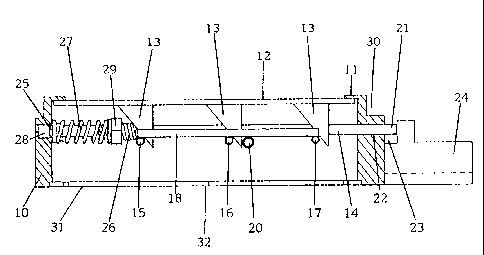Some of the information on this Web page has been provided by external sources. The Government of Canada is not responsible for the accuracy, reliability or currency of the information supplied by external sources. Users wishing to rely upon this information should consult directly with the source of the information. Content provided by external sources is not subject to official languages, privacy and accessibility requirements.
Any discrepancies in the text and image of the Claims and Abstract are due to differing posting times. Text of the Claims and Abstract are posted:
| (12) Patent: | (11) CA 2249680 |
|---|---|
| (54) English Title: | TRIGGER MECHANISM |
| (54) French Title: | MECANISME DE DECLENCHEMENT |
| Status: | Expired and beyond the Period of Reversal |
| (51) International Patent Classification (IPC): |
|
|---|---|
| (72) Inventors : |
|
| (73) Owners : |
|
| (71) Applicants : |
|
| (74) Agent: | MARKS & CLERK |
| (74) Associate agent: | |
| (45) Issued: | 2007-08-21 |
| (22) Filed Date: | 1998-10-07 |
| (41) Open to Public Inspection: | 1999-04-08 |
| Examination requested: | 2003-09-09 |
| Availability of licence: | N/A |
| Dedicated to the Public: | N/A |
| (25) Language of filing: | English |
| Patent Cooperation Treaty (PCT): | No |
|---|
| (30) Application Priority Data: | |||||||||
|---|---|---|---|---|---|---|---|---|---|
|
A trigger mechanism for an animal trap is disclosed, comprising a trigger plate moveable in a vertical direction and provided with at least one cam surface on its lower face, a retaining pin for preventing release of the trap until triggered, slidable longitudinally thereby to allow release of the trap, the retaining pin being linked to at least one cam follower, such that downward movement of the trigger plate causes the retaining pin to slide thereby causing release of the trap. The trigger plate and the retaining pin are preferably biassed in an adjustable manner so as to allow a degree of selectivity in the animals which are caught.
Mécanisme de détente d'un piège à animal, comprenant une plaque de déclenchement amovible à la verticale et munie d'au moins une surface de came sur la face inférieure, une tige de retenue qui empêche le déclenchement du piège sans élément déclencheur et qui glisse de manière longitudinale pour permettre le déclenchement du piège, la tige de retenue étant rattachée à au moins un galet de came, de sorte que le mouvement vers le bas de la plaque de déclenchement fait glisser la tige entraînant le déclenchement du piège. La plaque de déclenchement et la tige de retenue sont de préférence biaisées de manière ajustable pour permettre une certaine sélection des animaux piégés.
Note: Claims are shown in the official language in which they were submitted.
Note: Descriptions are shown in the official language in which they were submitted.

2024-08-01:As part of the Next Generation Patents (NGP) transition, the Canadian Patents Database (CPD) now contains a more detailed Event History, which replicates the Event Log of our new back-office solution.
Please note that "Inactive:" events refers to events no longer in use in our new back-office solution.
For a clearer understanding of the status of the application/patent presented on this page, the site Disclaimer , as well as the definitions for Patent , Event History , Maintenance Fee and Payment History should be consulted.
| Description | Date |
|---|---|
| Time Limit for Reversal Expired | 2014-10-07 |
| Letter Sent | 2013-10-07 |
| Inactive: Late MF processed | 2011-11-14 |
| Letter Sent | 2011-10-07 |
| Grant by Issuance | 2007-08-21 |
| Inactive: Cover page published | 2007-08-20 |
| Pre-grant | 2007-06-05 |
| Inactive: Final fee received | 2007-06-05 |
| Notice of Allowance is Issued | 2006-12-05 |
| Letter Sent | 2006-12-05 |
| Notice of Allowance is Issued | 2006-12-05 |
| Inactive: Approved for allowance (AFA) | 2006-11-20 |
| Amendment Received - Voluntary Amendment | 2006-02-13 |
| Inactive: S.30(2) Rules - Examiner requisition | 2005-08-11 |
| Letter Sent | 2003-09-30 |
| Letter Sent | 2003-09-24 |
| Request for Examination Requirements Determined Compliant | 2003-09-09 |
| All Requirements for Examination Determined Compliant | 2003-09-09 |
| Request for Examination Received | 2003-09-09 |
| Inactive: Entity size changed | 2002-10-01 |
| Application Published (Open to Public Inspection) | 1999-04-08 |
| Inactive: Correspondence - Formalities | 1998-12-29 |
| Inactive: First IPC assigned | 1998-12-09 |
| Classification Modified | 1998-12-09 |
| Inactive: IPC assigned | 1998-12-09 |
| Inactive: Filing certificate - No RFE (English) | 1998-11-17 |
| Filing Requirements Determined Compliant | 1998-11-17 |
| Application Received - Regular National | 1998-11-17 |
There is no abandonment history.
The last payment was received on 2006-10-03
Note : If the full payment has not been received on or before the date indicated, a further fee may be required which may be one of the following
Please refer to the CIPO Patent Fees web page to see all current fee amounts.
Note: Records showing the ownership history in alphabetical order.
| Current Owners on Record |
|---|
| GEORGE ROSE |
| Past Owners on Record |
|---|
| HUGH QUENTIN ROSE |